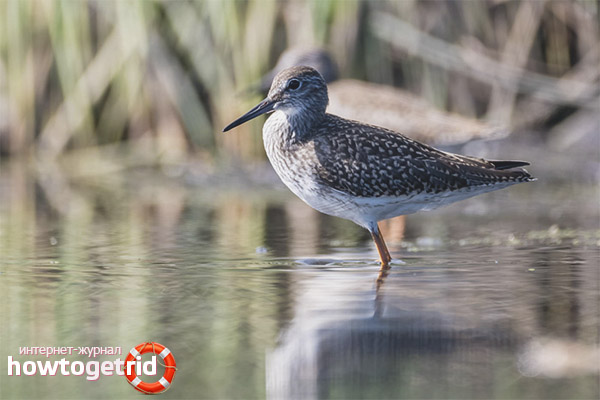The content of the article
During rains, the river overflows, then returns to the channel, but large huge reservoirs remain. Often near them you can meet a sandpiper, thoughtfully standing on one paw and hiding a large red beak under the wing. This is a herbalist resting. What kind of bird is this?
Appearance
At the first glance, it is immediately evident that the bird has a considerable relationship with the snipe. An adult herbalist the size of a small thrush, reaches about 30 centimeters in length and weighs 170-180 grams. Wingspan - 65-67 centimeters.
A line by which it is easy to identify this bird is the red, sometimes orange color of its beak and legs. And the beak is not all that color - the tip is black. The body is covered with black-brown, darker on the back, turning into a light plumage on the tummy with black and gray mottles. A strip of white color runs along the edge of the wings, along which the flying grass is easy to recognize - this is a kind of indicator and a distinctive sign.
Habitat
In Russia, it is found in large numbers in the south and west of Siberia, sometimes reaching the northern taiga regions. Many herbalists live in Transbaikalia. The bird belongs to the migratory ones; it leaves for winter in the warmer lands - in southern Africa, the Arabian Peninsula, in the South Asian warm countries, in Indonesia, India, Pakistan, and even reaches distant Australia.
Breeding
Herbalists fly home from their wintering places in late March - early April, sometimes in packs, sometimes in small groups or singly. The males are the first to arrive on their native land and begin to wait for the females. After waiting, they begin tocock, flying around the female and whistling melodiously and beautifully. This beautiful singing is another feature of the herbalist, which makes it easy to recognize.
Having formed a pair, the birds mate, begin to build a nest. For nesting, choose grassy terrain, make a small hole in the ground and cover it with bunches of last year's grass lying nearby with dried leaves or moss. Some individuals do not make a litter - eggs lay directly on the ground. In clutch from 1 to 5 pear-shaped ocher, sometimes greenish eggs. Both parents incubate, carefully guarding the masonry and driving away uninvited guests. It comes to the fact that sometimes you have to fight with those who want to steal a future brood - crows, magpies.
The female leaves the nest shortly before the birth of the offspring, the male continues to incubate alone. After 25-27 days, chicks appear, which is raised by one father for about a month, after 25-27 days, young pies begin to fly. Chicks become sexually mature only in the second year of life.
Nutrition

Herbalist is mostly carnivorous, feeds on water and land insects. On land, it catches dragonflies, butterflies, picks and pecks larvae, hunts grasshoppers and praying mantises, eats across worms. It extracts snails, mollusks, crayfish and tadpoles in water. Having long legs, he walks on the water and with the help of an elongated beak collects the prey from the bottom. Vegetable food is not shy either, with pleasure biting seeds from herbs.
Interesting
Due to the bright red color of the paws, the herbalist bears another name - the centipede.
Outwardly, males cannot be distinguished from females; they are very similar both in size and in appearance.
During the day, birds fly a very long way - more than a thousand kilometers. The longest recorded flight length is 1320 kilometers.
The life expectancy of the herbalist is quite large - 17-18 years.
This bird nests from year to year in the same familiar and familiar place, very carefully masking the nest from idle eyes. It comes to the point that the hen herself disguises herself, hiding behind bunches of grass, she knows about the danger only by a signal given by her husband.
By the way, in order to easily notice the danger, waders settle near gulls and terns - they notify when they discover uninvited guests or dangerous predators.
Video: Herbalist (Tringa totanus)










Submit